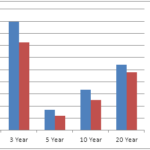Previously, I laid the case for why yield-hungry investors were driving investment returns. Yields are depressed in every corner of the market, from risk-free treasuries to riskier levered REITs and junk bonds.
That doesn’t stop new ETF creation, however. Dividends are Main Street’s way into Wall Street; even Jim Cramer hopped on board to call for a rotation from fixed-income to dividend-paying equity securities.
New funds in the space
WisdomTree (WETF), the only publicly-traded ETF sponsor and asset manager, has two new dividend funds waiting for regulatory approval.
The first is the WisdomTree U.S. Dividend Growth Fund (DGRW) which uses a passive strategy that includes all the stocks in its proprietary U.S. Dividend Growth Index of 300 companies. The index sorts through stocks for a combination of dividend growth, current yield, and quality. Index components must have paid dividends for the last 12 months, and have a current market cap in excess of $2 billion. It seems likely that the index will mirror the exposure of broad based indexes. The fund will hold no more than 20% of its portfolio in a single sector – there are 10 “official†sectors in the S&P 500 (SPY) index.
The U.S. Dividend Growth fund has a mix of stocks that are widely-held by large cap dividend investors:
1. Apple Inc 4.81%
2. Microsoft Corp 4.30%
3. Procter & Gamble Co 3.70%
4. Wal-Mart Stores Inc 3.61%
5. Coca-Cola Co 3.00%
The dividend fund’s best comparable is Vanguard’s Dividend Appreciation ETF (VIG), which looks for similar fundamental qualities of top dividend-paying stocks. Interestingly, the difference between WisdomTree’s fund and Vanguard’s fund will likely be the performance of Apple, which makes nearly 5% of WisdomTree’s ETF, but is not included in Vanguard’s dividend appreciation ETF. A small difference in fees (28 basis points for WisdomTree, and .13% for Vanguard) may be worth the price given that the Dividend Growth Fund does not go on the defensive. WisdomTree thew out capital-intensive, slow-growing utilities as a whole, holding absolutely nothing in the very defensive, very bubbly space of public energy and infrastructure.
Small cap dividend funds
A second fund from WisdomTree makes for a more interesting play on small cap stocks. The WisdomTree U.S. Small Cap Dividend Growth Fund (DES) will offer unique exposure to smaller, dividend-paying companies on Amercan markets. The fund will hold stocks in the bottom quartile of market cap in its own U.S. Dividend Growth Index, after removing all of the largest 300 names, which are the subject of its larger dividend growth fund. The prospectus gives investors some perspective on size – included companies must have a market cap of at least $100 million and paid dividends for at least 12 months. Again, this fund will seek to hold no more than 2% of assets in one company and no more than 20% of assets in a single sector.
The fund taps into two truths in finance: small caps and dividend paying stocks offer above-average performance in the long haul. This fund could make for an interesting alternative for people who want riskier exposure with current (and hopefully growing) income into the future.
Very broadly diversified, the fund taps into 643 different stocks while offering an impressive 2.56% distribution yield – far higher than VIG’s paltry sub-2% yield after adjusting for last year’s one time special dividends. At .38% it’s not particularly expensive, either, in line with most small cap funds.
There’s a new leader in the dividend growth space. WisdomTree’s U.S. Dividend Growth Fund (DGRW) is by far the best for long-term dividend growth for the simple reason that it does not invest in public utilities. The small cap dividend ETF still needs a track record to prove its potential. Given that it will dive into very small securities, some of which won’t have a liquid market, a lack of liquidity may weigh on investment performance.
Disclosure: No position in any tickers mentioned here.










{ 0 comments… add one now }